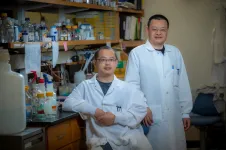(Press-News.org) Many middle-aged and older women get mammograms every one to two years to screen for breast cancer, as recommended by their doctors. A study by researchers at Washington University School of Medicine in St. Louis indicates that previous mammograms hold underutilized data that could help identify women at high risk of breast cancer and even reveal which breast is likely to be affected.
When doctors read mammograms, they assess breast density along with signs of cancer, comparing a woman’s previous mammograms to her most recent one to look for worrisome changes. But some changes are difficult to detect by eye.
In the study, researchers used a mathematical model to monitor changes in breast density over the course of a decade in almost 1,000 women and found that the rate of change differed significantly between the nearly 300 women who were later diagnosed with cancer and those who were not. The findings, available online in JAMA Oncology, could help refine current risk algorithms and aid efforts to identify women who could benefit from additional screening.
“Our best tool against breast cancer is early detection,” said senior author Graham A. Colditz, MD, DrPH, associate director of Siteman Cancer Center at Barnes-Jewish Hospital and Washington University School of Medicine. “By adding the change in density over repeated images to models for risk classification in each breast, we set the stage for a better risk estimation with each updated mammogram. We can then better classify future risk and refer women to appropriate prevention strategies such as enhanced screening as part of routine breast health services.”
Doctors estimate a woman’s risk of breast cancer using factors including age, family history, presence of high-risk genetic variants and breast density. Women considered to be at high risk are referred for supplemental screening, which typically means annual magnetic resonance imaging (MRI) scans in addition to annual mammograms.
Nobody really knows why women with denser breasts are more likely to develop breast cancer. First author Shu Jiang, PhD — an associate professor of surgery in the Division of Public Health Sciences within the Department of Surgery, and a research member at Siteman — saw in repeated mammograms an untapped source of data on breast density and how it changes over time in individual breasts that might shed light on the relationship between density and disease.
She analyzed data on women in the Joanne Knight Breast Health Cohort at Siteman Cancer Center. The cohort was established by Colditz, the Niess-Gain Professor of Surgery and director of the Division of Public Health Sciences, and colleagues in 2008 to study risk factors and improve models for breast cancer risk prediction. It comprises a diverse group of more than 10,000 women who were free from cancer when they joined.
Jiang identified 289 women in the cohort who had developed cancer and compared them to 658 similar women in the cohort who did not. Each woman had received regular mammograms, so Jiang was able to collect and analyze a total of 8,710 single-breast images, representing an average of four time points over a 10-year period for each woman.
Since breast cancer rarely develops in both breasts at the same time, Jiang analyzed the images of each breast separately. Women’s breasts normally become less dense as they age, but Jiang discovered that density declined significantly more slowly in the breasts that later developed cancer than in those that did not.
“In the future, I think we can use a woman’s past history of density, plus her current density estimate, to better understand her risk level,” Jiang said. “We may even be able to determine which breast will be affected, because the density signal is strongest in the breast that goes on to develop cancer. Many women already get regular mammograms, so the data on density in each breast is already being collected. We just need to use the data more effectively.”
Colditz, Jiang and colleagues are now working on translating the findings into a form that can be used to enhance patient care. They are developing prediction models that incorporate change in breast density over time, and plan to validate the models in independent data sets so they can be used in clinical care.
END
Change in breast density over time linked to cancer risk
Monitoring density in each breast could help assess risk
2023-05-09
ELSE PRESS RELEASES FROM THIS DATE:
New study suggests that SARS-CoV-2 might induce lasting pain in unique way
2023-05-09
(Boston)—COVID-19, the disease resulting from SARS-CoV-2 infection, is associated with highly variable clinical outcomes that range from asymptomatic disease to death. For those with milder infections, COVID-19 can produce respiratory infection symptoms (cough, congestion, fever) and sensory phenotypes such as headache and loss of sense of smell. In more severe cases, SARS-CoV-2 infection can affect nearly every organ and result in strokes from vascular occlusion, cardiovascular damage and acute renal failure. ...
New method uses engineered bacteria and AI to sense and record environmental signals
2023-05-09
New Method Uses Engineered Bacteria and AI to Sense and Record Environmental Signals
Columbia synthetic biologists first to engineer bacterial swarm patterns to visibly record environment, use deep learning to decode patterns; applications could range from monitoring environmental pollution to building living materials
New York, NY—May 9, 2023—Researchers in Biomedical Engineering Professor Tal Danino’s lab were brainstorming several years ago about how they could engineer and apply naturally-pattern-forming bacteria. There are many bacteria species, such as Proteus mirabilis (P. mirabilis), that self-organize into defined patterns on solid surfaces that are visible ...
Increasing prosperity linked to unhealthy eating patterns in Kenyan youth
2023-05-09
Philadelphia, May 9, 2023 – The increase in obesity in lower-middle-income countries (LMIC) is largely thought to be affected by lifestyle transition away from traditional diets toward unhealthy Western dietary patterns that follow economic development. This study in the Journal of Nutrition Education and Behavior, published by Elsevier, collected data on eating and physical activity behaviors from families in two socioeconomically-different communities in Nairobi, Kenya. Researchers found that increasing prosperity is linked to unhealthy eating patterns in Kenyan preadolescents.
"Dietary ...
Systematic racism in healthcare boosted COVID-19 vaccine mistrust in Black communities: Study
2023-05-09
The University of Ottawa’s Interdisciplinary Centre for Black Health survey reveals scope of coronavirus vaccine hesitancy in Black communities in relation to healthcare.
The health care system must play a significant role in combatting COVID-19 mistrust among Black individuals in Canada according to a new University of Ottawa study that found distrust in the healthcare network was so profound that educated individuals were hesitant to receive the vaccine.
Professor Jude Mary Cénat, Associate Professor in the School of Psychology at the Faculty of Social Sciences, is the Chair of the Interdisciplinary Centre ...
Hey Siri, can you hear me? #ASA184
2023-05-09
CHICAGO, May 9, 2023 – Millions of people now regularly communicate with AI-based devices, such as smartphones, speakers, and cars. Studying these interactions can improve AI’s ability to understand human speech and determine how talking with technology impacts language.
In their talk, “Clear speech in the new digital era: Speaking and listening clearly to voice-AI systems,” Georgia Zellou and Michelle Cohn of the University of California, Davis will describe experiments to investigate how speech and comprehension change when humans communicate ...
Lack of belief in body’s ability to function through pain linked to daily pre-surgery prescribed opioid use among candidates for elective spine surgery
2023-05-09
According to a new Johns Hopkins Medicine study, low pain self-efficacy can predict daily pre-surgery prescribed opioid use among patients seeking elective spine surgery. The study defined pain self-efficacy as the “beliefs held by people with chronic pain that they can carry out certain activities, even when experiencing pain.” Previous studies showed that lower pain self-efficacy is associated with higher pain intensity and greater pain interference in day-to-day life. However, the Johns Hopkins research team believes its study is among the first to investigate ...
Reduced cancer mortality with daily vitamin D intake
2023-05-09
Vitamin D intake could reduce cancer mortality in the population by twelve percent - provided the vitamin is taken daily. This was the result of an evaluation of 14 studies of the highest quality conducted at the German Cancer Research Center with a total of almost 105,000 participants.
Vitamin D deficiency is widespread worldwide and is particularly common among cancer patients. Averaged over the year, the vitamin D blood levels of about 15 percent of German adults are below the threshold for a pronounced vitamin D deficiency*. In contrast, in a study of colorectal ...
Scientists develop AI tool to predict Parkinson’s disease onset
2023-05-09
Scientists from UNSW Sydney with collaborators at Boston University have developed a tool that shows early promise in detecting Parkinson’s disease years before the first symptoms start appearing.
In research published today in the journal ACS Central Science, the researchers described how they used neural networks to analyse biomarkers in patients’ bodily fluids.
The researchers from UNSW School of Chemistry examined blood samples taken from healthy individuals gathered by the Spanish European ...
SwRI selected for Phase A study to develop next-generation NOAA coronagraph
2023-05-09
SAN ANTONIO — May 9, 2023 —NASA has selected Southwest Research Institute for a Phase A study to develop SwRI’s Space Weather Solar Coronagraph (SwSCOR) on behalf of the National Oceanic and Atmospheric Administration (NOAA). NOAA’s Space Weather Next Program is charged with providing critical data for its space weather prediction center. SwRI is one of five organizations developing a definition-phase study to produce the next-generation NOAA L1 Series COR instrument to detect and characterize Earth-directed coronal mass ejections (CMEs).
CMEs are huge bursts of coronal plasma threaded with intense magnetic fields ...
Long molecule of RNA essential to our GI tract’s ability to contract and move food along
2023-05-09
AUGUSTA, Ga. (May 9, 2023) – A long molecule of RNA found in abundance in the healthy smooth muscle cells that give our blood vessels strength and flexibility is also essential to the continuous contraction that moves food through our gastrointestinal tract.
Without CARMN, a long, noncoding RNA, which means it doesn’t produce proteins but does help regulate cell activity, the 30-foot-long GI tract doesn’t contract as it should.
That can result in a painful even lethal situation where partially undigested food gets ...
LAST 30 PRESS RELEASES:
This new understanding of T cell receptors may improve cancer immunotherapies
A new fossil face sheds light on early migrations of ancient human ancestor
A new immunotherapy approach could work for many types of cancer
A new way to diagnose deadly lung infections and save lives
40 percent of MRI signals do not correspond to actual brain activity
How brain-inspired algorithms could drive down AI energy costs
Gum disease may be linked to plaque buildup in arteries, higher risk of major CVD events
Contrails are a major driver of aviation’s climate impact
Structure of dopamine-releasing neurons relates to the type of circuits they form for smell-processing
Reducing social isolation protects the brain in later life
Keeping the heart healthy increases longevity even after cancer
Young adults commonly mix cannabis with nicotine and tobacco
Comprehensive review illuminates tau protein's dual nature in brain health, disease, and emerging psychiatric connections
Book prepares K-12 leaders for the next public health crisis
Storms in the Southern Ocean mitigates global warming
Seals on the move: Research reveals key data for offshore development and international ecology
Sports injuries sustained during your period might be more severe
World's first successful 2 Tbit/s free-space optical communication using small optical terminals mountable on satellites and HAPS
Can intimate relationships affect your heart? New study says ‘yes’
Scalable and healable gradient textiles for multi‑scenario radiative cooling via bicomponent blow spinning
Research shows informed traders never let a good climate crisis go to waste
Intelligent XGBoost framework enhances asphalt pavement skid resistance assessment
Dual-function biomaterials for postoperative osteosarcoma: Tumor suppression and bone regeneration
New framework reveals where transport emissions concentrate in Singapore
NTP-enhanced lattice oxygen activation in Ce-Co catalysts for low-temperature soot combustion
Synergistic interface engineering in Cu-Zn-Ce catalysts for efficient CO2 hydrogenation to methanol
COVID-19 leaves a lasting mark on the human brain
Scientists use ultrasound to soften and treat cancer tumors without damaging healthy tissue
Community swimming program for Black youth boosts skills, sense of belonging, study finds
Specific depressive symptoms in midlife linked to increased dementia risk
[Press-News.org] Change in breast density over time linked to cancer riskMonitoring density in each breast could help assess risk




